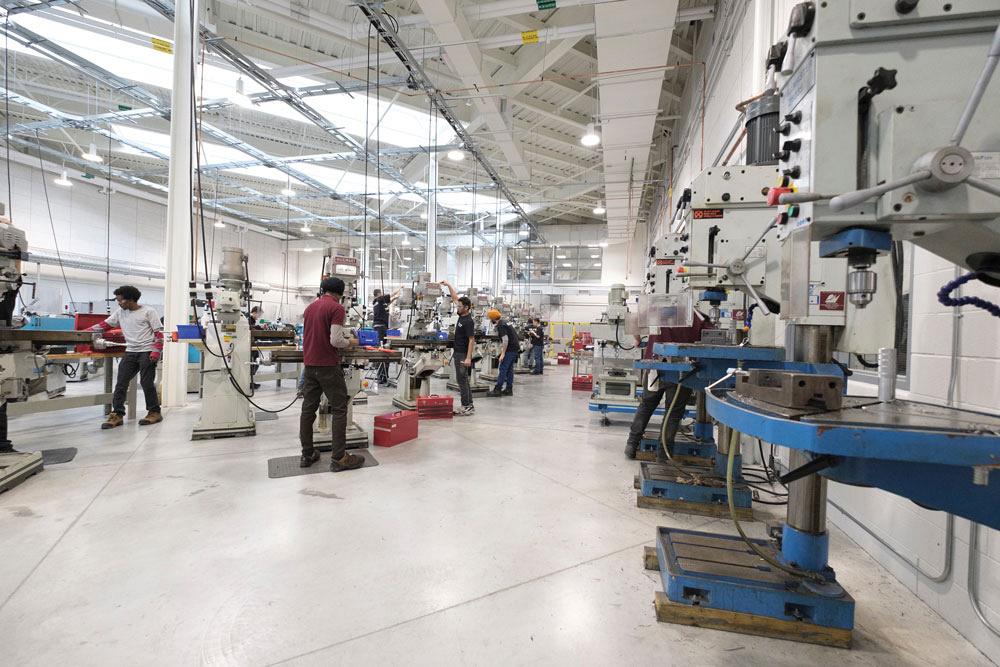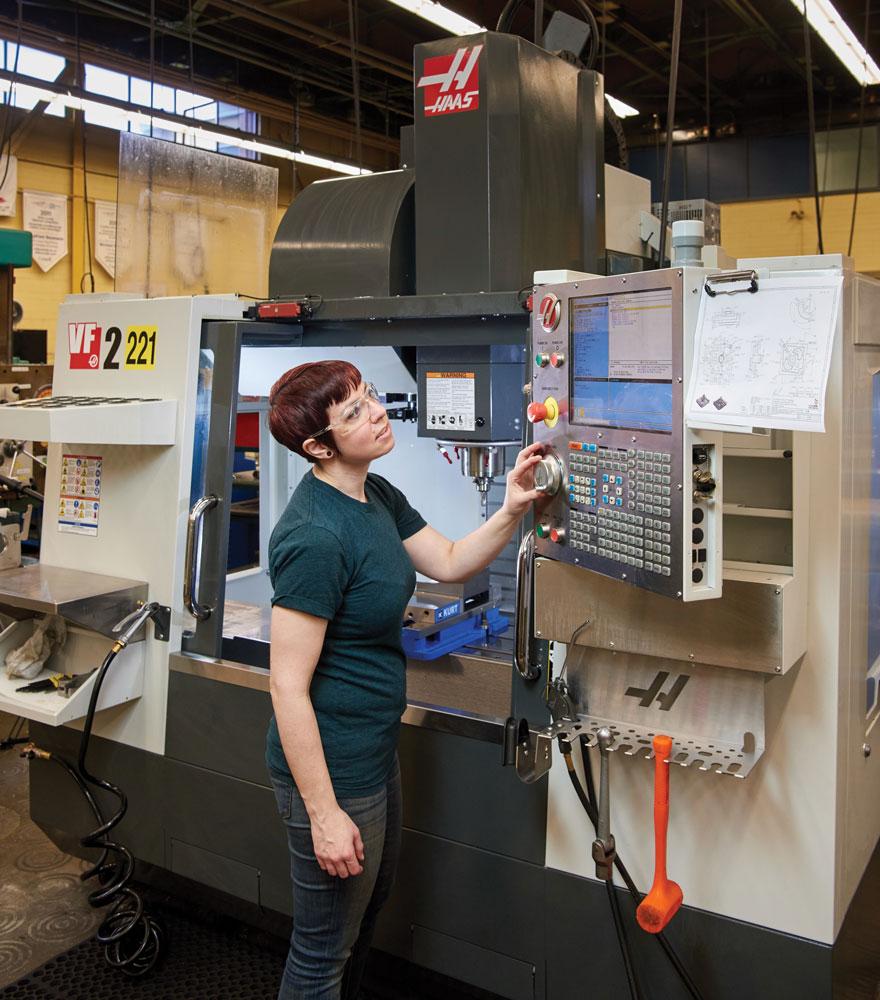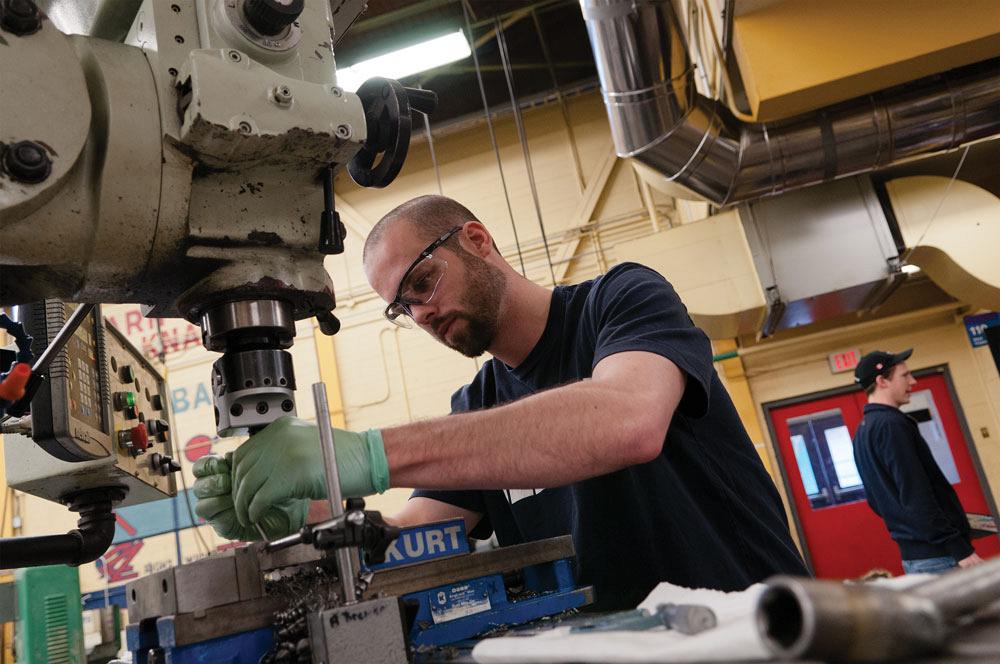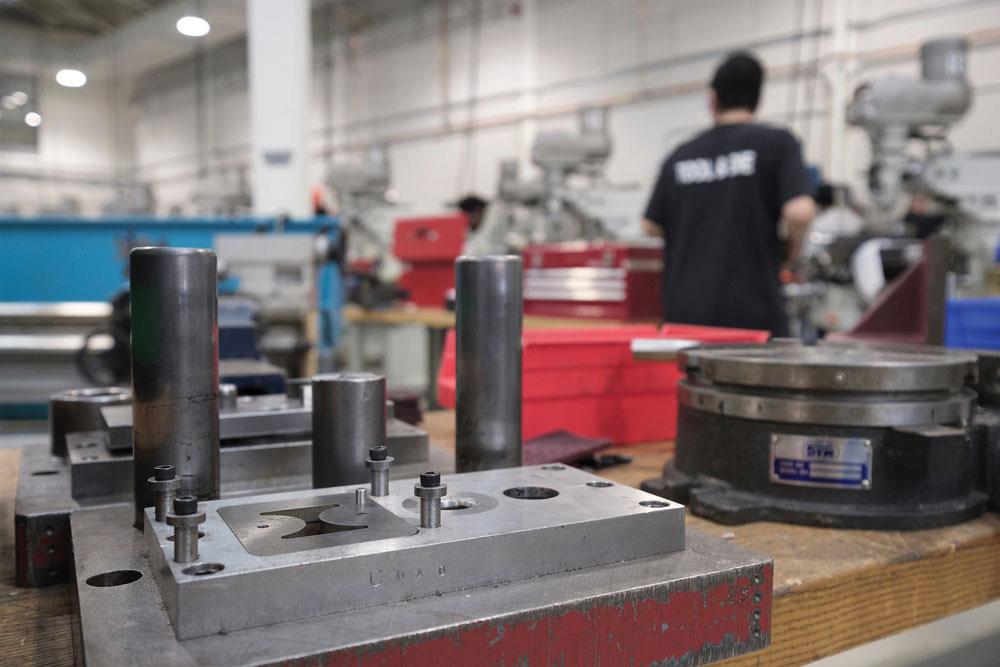Associate Editor
- FMA
- The Fabricator
- FABTECH
- Canadian Metalworking
A pandemic approach: Part I
Canada’s colleges have been forced to rethink skilled trades training
- By Lindsay Luminoso
- March 23, 2021
- Article
- Health & Safety

Liao said that jobs in the industry and workers who have a college or trades designation have recovered to about 95 per cent of pre-pandemic-level employment, which is cause for optimism. Sheridan
In Part I of this two-part series we look at how two colleges, British Columbia Institute of Technology (BCIT) and Sheridan, rose to challenges the pandemic posed and adapted to meet student needs. Part II will appear in the April issue.
It’s not hard to overstate what a challenging year 2020 was for most people. The pandemic effect rippled through communities and forced many people to rethink how they perform the most basic of daily tasks. And don’t forget your mask! With province-wide shutdowns and strict COVID-19 protocols, Canada’s post-secondary institutions ground to a halt in March 2020, much like the rest of us. In the months that followed, colleges were forced to find new ways to teach and train the next generation of skilled trades workers.
BCIT
Located in British Columbia, BCIT has campuses throughout the Greater Vancouver Area, including its main campus in Burnaby. It was established as a vocational school in 1960 with an educational philosophy that focuses on the practical aspect of studies, offering a more hands-on experience rather than theoretical. Today the college accepts around 50,000 students, both full- and part-time studies.
“We have approximately 350 apprentices per year in our system ranging from Level 1 to Level 4,” said Stefano Pettenon, department head, machinist program, BCIT. “We are small but we’ve done very well over the years.”
Industry Focus. According to Pettenon, industry in B.C. is looking for workers with a high level of skill and diversification. Generally, manpower tends to be very expensive, so taking on one highly skilled tradesperson is more economical than several lower-skilled tradespeople. This has pushed many colleges to adapt training to include a diverse range of skill sets.
“We are getting into more automation, five-sided machining, working with twin- spindle lathes, and obviously taking advantage of the new dynamic milling with the CAM software, but we still focus on manual machining,” said Pettenon. “There is still a huge need for manual machining in this region, especially because we have a number of pulp mills and repair shops. Industries and equipment built in the 1940s are still up and running, which means we still need the job shop type of machinists. In our training program we still maintain the foundations, but we are obviously moving more into CNC and advanced technology.”
The province also has a large green-energy sector for which many of the machine shops are producing prototypes for this advanced technology. With growth of new sectors like green energy, flexibility is needed for viability. Shops are looking for workers who have the skills and can work in a number of different segments, because when one segment dries up, the shop can shift to another or diversify to remain in business. Pettenon gave the example of the oil and gas sector, which has struggled in recent years.
“If you're set up to do one type of thing, you're not going to last; you have to be flexible,” he said. “If as a machine shop you're tooled up just in one area and there is a downturn, you have to be able to adapt.”
Advanced Manufacturing and Opportunities. The machinist program uses solely Haas equipment and supports Mastercam and GibbsCAM software. Pettenon noted that the college will be including Fusion360 because many of the high school students coming into the program are more familiar with this software.
The program also has a number of live tooling lathes, 32 Haas control simulators, several 3+2-axis mills, and Vericut software.

BCIT, one of the only trades training colleges in the province with a CNC machining program, has approximately 350 apprentices per year ranging from Level 1 to Level 4. Scott McAlpine/BCIT
“Keeping up with technology is one of our big challenges,” said Pettenon. “But so is dealing with new materials, which tend to be more difficult to work with. In today’s environment, the machines have to be more accurate as well. So, the parts that we manufacture have to meet industry standards. Accuracy is huge.”
COVID-19 and Student Learning. As the pandemic took hold, many colleges and universities were forced to close. And when they were able to open up, strong restrictions were in place. Like industry, the colleges adapted to ensure students were able to learn and meet program requirements.
BCIT is currently running a blended program that has been broken into learning blocks where students do a month of online learning and then a month in the shop. Pettenon noted that many BCIT students are from out of town, so a weekly switch between theory and practical learning just didn’t make sense. This structure is more accommodating to students who don’t live nearby, especially as this is one of a few machinist programs in the province.
“Obviously, our capacity in our shop has gone down due to pandemic restrictions, so we’ve moved our third-year and fourth-year students strictly online because we feel they have the foundation skills,” said Pettenon. “We just go over the theory with them and they seem to be OK with it. It helps to have computer-literate students. And some students just can't get around that. And some students are upset because online learning isn’t what they signed up for. With machining, you obviously want hands-on learning.”
Once strict COVID protocols were put in place, the college opened up in mid-summer, bringing small groups of students in for condensed learning.
“We really haven't seen our intake drop or anything,” said Pettenon. “We've seen it fill up, and I got everything booked solid, so that's always good. Moving forward, I think we definitely need to look at blended learning as an option, especially in the CNC education with the CAM software, there is no reason we cannot teach that virtually.”
The benefit of moving to a more hybrid approach for BCIT is that it will result in more freedom logistically. Due to its size, and COVID-19 protocols, the school was able to accommodate only so many students because it just didn’t have the space or equipment. But with the transition to online learning, the program can add classes and move around how students work in its facilities.
The Future of Skilled Trades Training. Moving forward, Pettenon said that the lab setup is a priority and he believes that time and money need to be spent on remodelling the shop to make it feel more like a manufacturing centre to give students the real shop experience.
There will still be an emphasis on foundational skills and manual machining, but there will also be significant CNC skills training.
“We find that you get a stronger student when they have the basics like manual machining foundations,” said Pettenon. “And many of our industries still work with manual, so I don’t see that going away. We are working to get more and more of our students back on campus and that hands-on learning that they expect from us. It’s not easy, but we are hopeful.”

BCIT is currently running a blended program broken into learning blocks rotating one month of online learning with a month of in-shop learning. Scott McAlpine/BCIT
Sheridan College
Sheridan was founded in 1967 as a local college in Brampton, Ont., and has since expanded to include campuses in Mississauga and Oakville. Its Davis Campus in Brampton, its largest, is home to the Magna Skilled Trades Centre, a state-of-the-art facility for skilled trades and apprenticeship programs. Across all its campuses and programs, Sheridan has more than 40,000 full-time, part-time, and continuing education students.
Industry Focus. The college has been exploring the further development of microcredentials and upskilling opportunities to attract new learners.
“The Ontario government has supported the introduction of more modular forms of training,” said Daniel Liao, associate dean, Magna School for the Skilled Trades, Sheridan. “We responded by securing funding through the Rapid Skills program and introducing a CNC microcredential project that focuses on upskilling for general labourers who are already established in the manufacturing industry.”
The project gives workers the opportunity to develop valuable new skills. Sheridan is halfway through the delivery of the initiative that includes 24 participants and has received great support and interest from industry partners.
Following its success with CNC upskilling, Sheridan is exploring using its microcredential framework to support other areas in the skilled trades.
Advanced Manufacturing and Opportunities. In December 2020, Sheridan College announced it had received a $2 million gift from automotive technology supplier Magna.
“The donation was incredible,” said Liao. “The majority of it is earmarked towards Sheridan students and outfitting our programs with cutting-edge equipment and the latest technologies. We are looking at robotic welding units, wire EDM, advanced PLC, and technology for greater connectivity to enhance the attainment of digital skills.”
In 2017 Sheridan moved its skilled trades and apprenticeship programs from Oakville to a state-of-the-art, purpose-built facility in Brampton. It houses 130,000 sq. ft. of teaching space and 65,000 sq. ft. of lab space. The staff and faculty at the recently renamed Magna School for the Skilled Trades are looking forward to continuing to procure the latest and greatest equipment to keep programs aligned with industry.
COVID-19 and Student Learning. The pandemic has presented Liao and the college with an opportunity to evaluate current priorities and explore opportunities for change. One of Liao’s areas of focus is making training more accessible and attracting more students into the trades.
“Due to the COVID-19 pandemic, we were forced to pause in-person program delivery for a time, which delayed some training, but we fortunately didn’t have any program cancellations,” said Liao. “Under normal circumstances, we would teach in sections of 24 students, but we had to drop down to 12 because of Ministry-wide physical distancing measures. To address the challenge, we started utilizing Saturdays and Sundays for training.”

To deal with pandemic disruptions, Sheridan delivered apprentices’ theory program components upfront for four to six weeks online. Then in September 2020, apprentices came to campus on weekends to cover all the hands-on, practical requirements in labs. Sheridan
To deal with the log jam of students moved to fall programs and necessary COVID-19 health and safety measures, Sheridan decided to deliver apprentices’ theory program components upfront for four to six weeks online. Once the program facilities opened back up in September 2020, apprentices came to campus on weekends to cover all the hands-on, practical requirements in labs.
“We pivoted and found ways to accommodate all of our classes under pandemic measures,” said Liao. “We’d never before structured programs by having all the theory delivered full-time for a month followed by three months of hands-on learning. It was successful.”
Liao is exploring whether this structure will be sustainable after the pandemic. This new model could be less disruptive to employers who release their employees for apprenticeship training and easier on apprentices who wouldn’t have to travel back and forth between work and school.
The Future of Skilled Trades Training. “We were forced to retool during the pandemic, and that's been reasonably successful,” said Liao. “Our apprentices are very closely linked to industry so it creates improved pathways for those who are looking to start a trades career. Jobs in our industry and workers who have a college or trades designation have recovered to about 95 per cent of pre-pandemic-level employment. I think that's cause for optimism.”
The college is already starting to see recovery from pandemic disruptions. Its two-year diploma program for toolmaking, for example, requires a full-year placement, which was hard to come by during lockdowns. However, Liao said that most of the students have successfully been placed in related fields. And many of Sheridan’s skilled trades programs have gotten more interest from prospective students.
“We want to see this kind of steady demand for our programs,” said Liao. “We don't want to see volatility because that can be difficult for planning. What's fall of 2021 going to be like? What's winter of 2022 going to be like? Will there be all this pent-up demand in industry, and how can we be ready for it? I anticipate in the next 18 months there will be a doubling down on efforts to attract talent and get more students into skilled trades training programs.”
Liao said that he is excited about the results of Sheridan’s efforts to get more youth into the trades and increase student diversity. He hopes to continue to remove stigma associated with working in the skilled trades and promote attractive options for a progressive education. One way Sheridan is achieving this is by keeping up with the latest trends and advanced technologies.
“Magna and many others are investing more in electric vehicles,” said Liao. “We keep a close eye on that industry and adjust our curriculum accordingly. As part of our electrical pre-trade, electrical techniques, and electrical engineering technician programs, we have a mandatory renewable energy component. It’s important to develop these skills to improve students’ future employment prospects.”
Check back next month for Part II of this article that looks at how Mohawk College and the Northern Alberta Institute of Technology (NAIT) have approached learning during the pandemic.
Associate Editor Lindsay Luminoso can be reached at lluminoso@canadianmetalworking.com.

Inside the Magna School for the Skilled Trades 2.jpg- In 2017 Sheridan moved its skilled trades and apprenticeship programs from Oakville to a state-of-the-art, purpose-built facility in Brampton recently renamed Magna School for the Skilled Trades. Sheridan
BCIT, www.bcit.ca
Sheridan College, www.sheridan.edu
About the Author

Lindsay Luminoso
1154 Warden Avenue
Toronto, M1R 0A1 Canada
Lindsay Luminoso, associate editor, contributes to both Canadian Metalworking and Canadian Fabricating & Welding. She worked as an associate editor/web editor, at Canadian Metalworking from 2014-2016 and was most recently an associate editor at Design Engineering.
Luminoso has a bachelor of arts from Carleton University, a bachelor of education from Ottawa University, and a graduate certificate in book, magazine, and digital publishing from Centennial College.
subscribe now


Keep up to date with the latest news, events, and technology for all things metal from our pair of monthly magazines written specifically for Canadian manufacturers!
Start Your Free Subscription- Industry Events
Automate 2024
- May 6 - 9, 2024
- Chicago, IL
ANCA Open House
- May 7 - 8, 2024
- Wixom, MI
17th annual Joint Open House
- May 8 - 9, 2024
- Oakville and Mississauga, ON Canada
MME Saskatoon
- May 28, 2024
- Saskatoon, SK Canada
CME's Health & Safety Symposium for Manufacturers
- May 29, 2024
- Mississauga, ON Canada




















